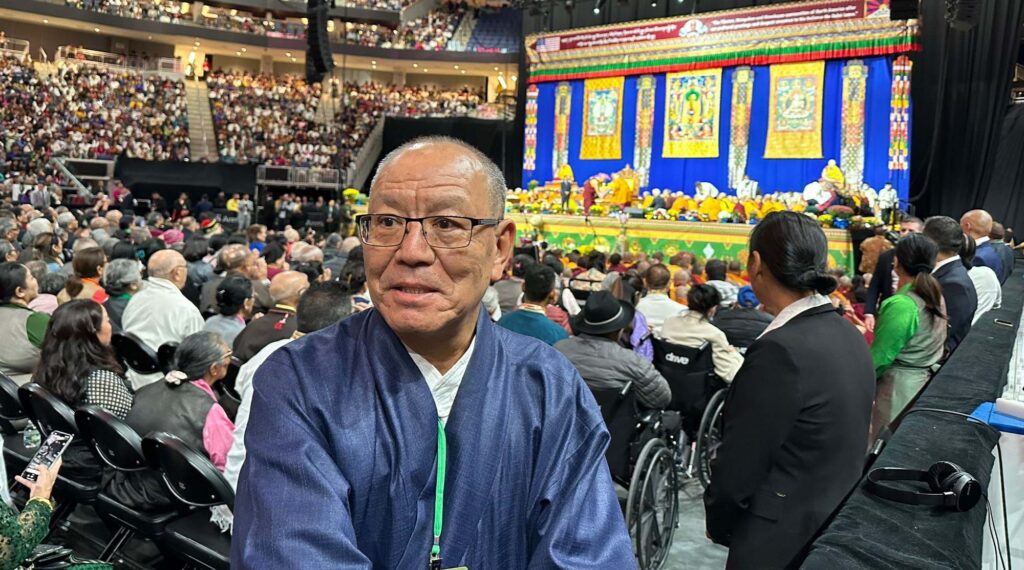In August this year, I had the intensely emotional experience of attending the event in New York organized by the Tibetan and Himalayan communities to make a Tenshug (long-live prayer) offering to His Holiness the Dalai Lama who was on a visit to the United States.
It was emotional for few reasons. First, the most recent visit of His Holiness to this part of the world took place way back in 2016, before the dreaded Covid19 pandemic.
Secondly, indications until this visit were that His Holiness would be limiting his international travel thus reducing the opportunity for devotees in this region to be in his direct presence and attend his teachings here.
Thirdly, and with this sort of reduced opportunity, all devotees and well-wishers were both overjoyed and concerned when learning that His Holiness was making an unprecedented visit to the United States for a knee surgery. To our collective relief, we were informed that His Holiness not only had a successful treatment, but that he would accept the devotees’ supplication for an opportunity to be in his presence.

The event took place in a packed ice hockey stadium in the outskirts of New York City. During the whole time that His Holiness the Dalai Lama was at the venue, there was palpable hysteria, although expressed differently than one would see at a music or a sports event. The way the over 17,000 people in the stadium reacted as soon as the giant monitor screen showed His Holiness coming toward the stage was something best left to be experienced.
The reason why I am referring to this event is because we are now celebrating the 17th anniversary of another historic event, the Congressional Gold Medal to His Holiness the Dalai Lama, which took place in Washington, DC on October 17, 2007. The legislation that mandated this award, S.2784 – Fourteenth Dalai Lama Congressional Gold Medal Act, in fact outline the reasons for this sort of public reverence to His Holiness. It acknowledged that His Holiness “is the unrivaled spiritual and cultural leader of the Tibetan people,” and one might extend this to other communities who consider themselves as his devotees.
Since 17 years have passed, let us recall the reasons the Congress outlined as the basis for its decision to bestow the award to His Holiness. It mentioned six points, saying the Dalai Lama:
- is recognized in the United States and throughout the world as a leading figure of moral and religious authority;
- is the unrivaled spiritual and cultural leader of the Tibetan people, and has used his leadership to promote democracy, freedom, and peace for the Tibetan people through a negotiated settlement of the Tibet issue, based on autonomy within the People’s Republic of China;
- has led the effort to preserve the rich cultural, religious, and linguistic heritage of the Tibetan people and to promote the safeguarding of other endangered cultures throughout the world;
- was awarded the Nobel Peace Prize in 1989 for his efforts to promote peace and non-violence throughout the globe, and to find democratic reconciliation for the Tibetan people through his “Middle Way” approach;
- has significantly advanced the goal of greater understanding, tolerance, harmony, and respect among the different religious faiths of the world through interfaith dialogue and outreach to other religious leaders; and
- has used his moral authority to promote the concept of universal responsibility as a guiding tenet for how human beings should treat one another and the planet we share.
So, as we celebrate the anniversary of the Congressional Gold Medal to His Holiness it is heartening to see the continued strong reverence people have for His Holiness. As the New York event (as well as the one in Zurich and subsequent public events in Dharamsala) showed, His Holiness is still there to provide us with pertinent advice. But it would even be more beneficial for us devotees and well-wishers to see how we can strengthen our work to fulfil His Holiness’ vision. For example, while re-reading His Holiness’ essay on A Human Approach to World Peace (written in the 1980s) recently for a work-related task, given the ongoing Russian war against Ukraine and the expanding violence in the Middle East, the universality of his message is something that we need to draw attention to.
For Tibetans, it is imperative that we use this occasion to take stock of the changing situation, whether His Holiness’ age, Chinese strategy on Tibet and His Holiness, Tibetan exile politics. We Tibetans need to get our priorities right, just as Gungthang Rinpoche advised us way back in the 18th century: “Do not cast aside the root, and (merely) grasp the branches” “(རྩ་བ་བོར་ནས་ཡལ་ག་མ་འཛིན་ཨང༌། གུང་ཐང་བསྟན་པའི་སྒྲོན་མེ།). I believe the time has come for Tibetans and the Tibet movement as a whole to consolidate our achievements and institutionalize them in the different countries where we reside.
